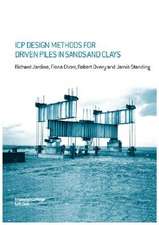A Comprehensive Database of Tests on Axially Loaded Piles Driven in Sand
Autor Zhongxuan Yang, Richard Jardine, Wangbo Guo, Fiona Chowen Limba Engleză Paperback – 10 noi 2015
- Presents a comprehensive and updated database for piles driven in predominantly silica sands
- Features reviews of the design procedures for driven piles in sand
- Assesses the performance of various mainstreams design procedures applied for piles driven in sand
- Provides comprehensive information of case histories of pile load tests
Preț: 509.70 lei
Preț vechi: 666.09 lei
-23% Nou
Puncte Express: 765
Preț estimativ în valută:
97.53€ • 102.09$ • 81.18£
97.53€ • 102.09$ • 81.18£
Carte tipărită la comandă
Livrare economică 24 martie-07 aprilie
Preluare comenzi: 021 569.72.76
Specificații
ISBN-13: 9780128046555
ISBN-10: 0128046554
Pagini: 262
Dimensiuni: 152 x 229 x 18 mm
Greutate: 0.43 kg
Editura: ELSEVIER SCIENCE
ISBN-10: 0128046554
Pagini: 262
Dimensiuni: 152 x 229 x 18 mm
Greutate: 0.43 kg
Editura: ELSEVIER SCIENCE
Public țintă
Research institutes and individuals working in offshore geotechnics and civil engineering, as well as oil and gas companiesCuprins
Preface1 Introduction2 Design methods and database assessments3 Description of the extended ZJU-IC database4 Calculation methods applied in database analysis5 Preliminary database analysis of method reliabilities6 Future perspectives7 Summary and conclusionsReferenceAppendix: Detailed listings of database entries






